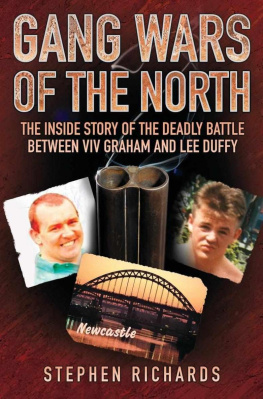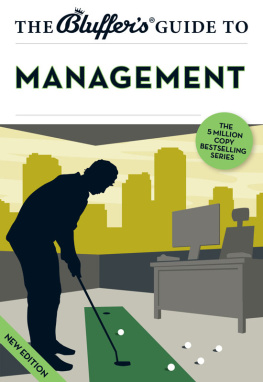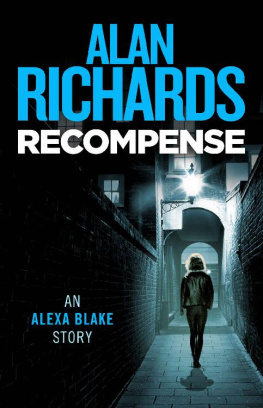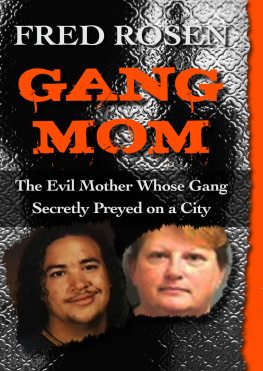T wo men whose names stood for violence Viv Graham and Lee Duffy, aka the Duffer fiercely resented each other. Sworn enemies, they ran parallel lives as pub and club enforcers, raging their gangland turf wars in a frenzy of brutality and unremitting cruelty. Engaging each other in a vicious gangland winner-takes-all fight was the ultimate challenge. Their clash ended in bloodshed, but in the end each man would meet an untimely and violent death at the hands of others.
INTRODUCING LEE DUFFY
L awrie and Brenda Duffy welcomed their newborn son, Lee Paul, later to be known as the Duffer, into the world on 11 June 1965. The boy was raised on a council estate in Middlesbroughs South Bank. After his first school, Beech Grove Primary, he attended Stapylton School in nearby Eston.
As early as the age of six, Duffy was repeatedly assaulted by much older boys if you can call lads of up to 19 boys.
And in 1979 a gang of older teenagers brutally attacked 14-year-old Duffy and knocked him unconscious. He was awarded 80 in compensation, but the taste of blood set him on the road to developing his skills as a boxer. Initially these were for self-defence but later, when he became a man mountain of six foot four and 16 stone, he dished out vengeance beatings to those involved in that assault.
West Indian Shandy Boyce is credited with teaching Duffy how to box, although many say that he never really took to boxing. But later Duffy would train at the gym and spar with any boxer. Every two or three weeks he would turn up on senior nights and knock someone out.
Duffy often recalled the bullying he suffered as a child and during his formative years this clearly played a part in traumatising him so that he wanted to fight. Psychologists say that the bullied becomes the bully.
By his teens Duffy was indoctrinated in the rough- and-tumble outlook that estates like his breed into youngsters and in December 1980, not yet 16, he received convictions for burglary and car theft and was sent to a detention centre for three months.
Duffy left Stapylton School in 1981 with a CSE Grade Three in woodwork.
The following year violence landed him in a detention centre for six months. Then, in April 1983, he was given a youth custody order lasting two and a half years for attacking and robbing a nightclub doorman.
Charges of affray and assault against Duffy were dropped in 1984 when no one would give evidence at court. (Four similar charges were dropped on separate occasions for the same reason.) That year Duffy met a single mother of one, Carol Bonnie Holmstrom, a South Bank girl three years older than him, and they began a turbulent five-year relationship.
Duffy was jailed in March 1988 for four years after pleading guilty to a vicious assault on a man in the Speakeasy nightclub (later the Havana) in Middlesbrough. The attack deprived his victim, Martin Clark, of an eye. While serving his sentence Duffy was moved to 18 different prisons. When strip-searched during these moves he became very aggressive. At each jail he wanted to take over and be top man.
In August 1988, while Duffy was behind bars, Bonnie gave birth to their second daughter, Michelle, and soon afterwards she told him that it was all over between them.
However, on being released from prison in May 1990, Duffy visited Bonnie in hospital, where she was being treated for stress. He broke down in tears and then went on holiday. On his return he broke the news to Bonnie that Lisa Stockell was pregnant with his child.
Duffys childhood hero was another of Teessides hard men, Kevin Ducko Duckling. He idolised the man and wanted to be like him when he got older. Duffy modelled himself on Ducko and similar hard men and maybe this is what helped mould him into the man he eventually became, although, as a family man, he was undoubtedly compassionate and cared about the two daughters he had with Bonnie and his daughter born to Lisa, Kattieleigh.
In June 1988 Ducko was charged with manslaughter and given a four-year prison sentence. He had shoved a partially disabled man from Sheffield, causing him to hit his head on the ground and die. The death of 21-year-old Paul Dallaway occurred at a blues party. These unlicensed gatherings, often organised and frequented by black people, sold alcohol and usually took place in terraced houses or disused commercial premises that had been converted in a rough-and -ready way. Once the pubs and clubs closed, people wanted the fun to go on and that is how blues parties developed. At one time, some cans of booze and a few grams of white powder or cannabis would get things going, but then the parties became commercialised and people started to make money out of running events where hundreds of paying guests would pack in.
Curry and rice would be served and drugs would be on sale to keep the party in full swing, while reggae tunes would blast out at full power. Usually an open fire was kept going to quickly burn drugs if the police raided. There would be plenty of prostitutes and illegal gambling on offer in the quieter rooms either upstairs or at the back of the house.
Blues parties were very dangerous places where you could get stabbed or shot, but Duffy chose them as his hunting ground for rich pickings from drug dealers. Soon his reputation went before him and he was a force second to none in the Middlesbrough area. Just the mention of his name would make drug dealers run a mile.
A look at Duffys past will show that he was much more orientated towards violence than his Newcastle counterpart Viv Graham ever was, and because of this he would receive a series of threats to his life.
Back in the 1980s, when Duffy was in his early twenties, he thought he could use his boxing prowess to carve out a reasonable living from crime. For people who make a decision like this, crime becomes a normal, accepted way of life. Court appearances were an occupational hazard for Duffy and, by 1988, when he was sentenced to four years for affray by Teesside Crown Court, he had seen the inside of a court over a dozen times, and more than once in connection with charges of violent crime.
No sooner was Duffy released from prison than he was in trouble again. This time, though, it was different. He was usually the one to dish out the punishment, but now he was on the other end of violence.
The early hours of a December morning in 1990 saw the industrial district of Middlesbrough disturbed by the noise of a shotgun. In the typical underworld way, Duffy had been shot in the knee. A man was later charged with the shooting and, because the damage was not as serious as it might have been, Duffy started to believe he was invincible. Over time he was called many names because of his violent behaviour, thug being one of the milder ones.















